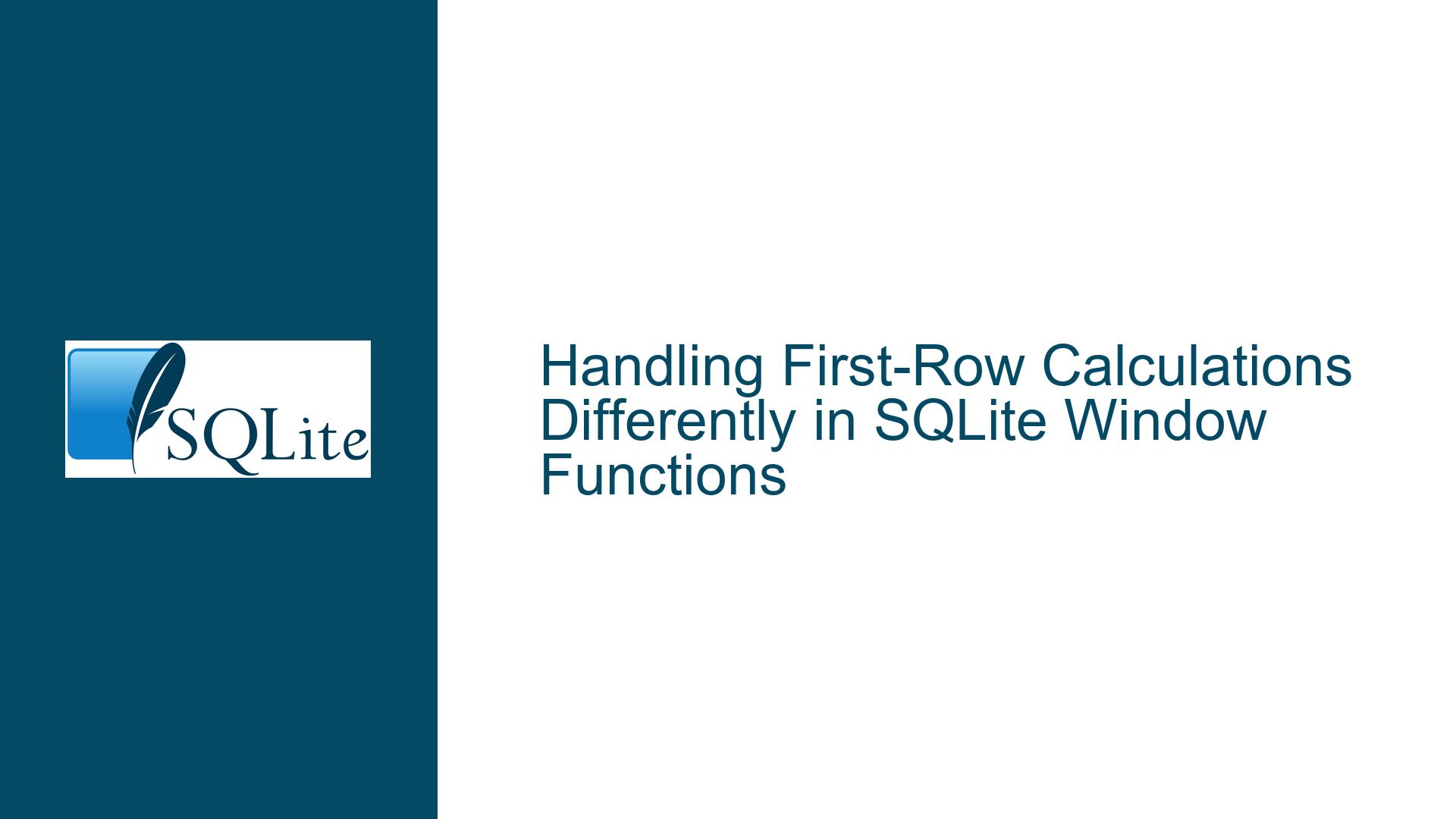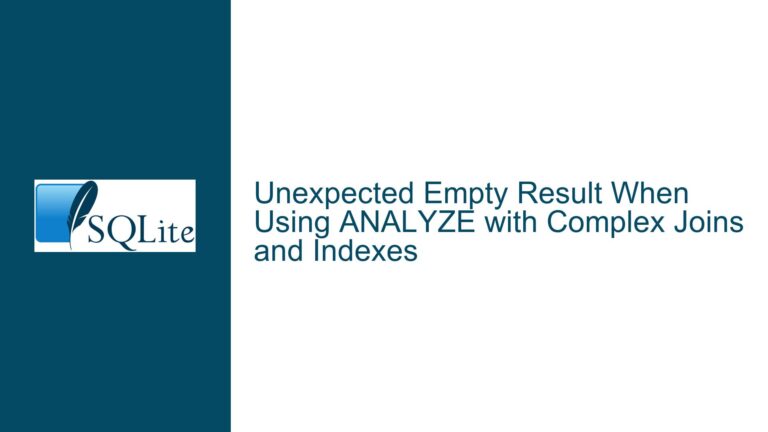Handling First-Row Calculations Differently in SQLite Window Functions
Understanding the Problem: First-Row Calculation Anomalies in Window Functions
The core issue revolves around calculating values in a table where the first row requires a different formula compared to subsequent rows. This is a common scenario when using window functions like LAG() in SQLite, where the first row inherently lacks a "previous" row to reference. In this case, the table calculategrowth contains columns such as TransactionId, pig, GrowthPool, and GrowthCarry. The goal is to compute two derived columns: EstGrowth and Diff.
The EstGrowth column is calculated differently for the first row compared to the rest. For the first row, the formula is TransactionId * 0.003 * 250, while for subsequent rows, it is ((TransactionId) - (lag(TransactionId, 1, 1) OVER w)) * 0.003 * 250. Similarly, the Diff column is calculated as GrowthPool / 1000000.0 - EstGrowth for the first row and (GrowthPool - Previous_GCOV) / 1000000 - EstGrowth for the rest.
The challenge arises because the first row does not have a previous row to reference, leading to NULL values in the LAG() function. This causes discrepancies in the calculations, as the formulas for EstGrowth and Diff are not applied correctly to the first row. The issue is further compounded by the fact that the incorrect calculation of the first row propagates errors to subsequent rows.
Identifying the Root Causes: Why the First Row Breaks the Calculation
The primary cause of the issue lies in the behavior of the LAG() window function. The LAG() function retrieves the value of a column from a previous row within the same window partition. For the first row in a partition, there is no previous row, so LAG() returns NULL. This NULL value disrupts the calculations for EstGrowth and Diff, as the formulas are not designed to handle NULL values gracefully.
Another contributing factor is the lack of a mechanism to differentiate between the first row and subsequent rows in the query. The query attempts to apply the same formula to all rows, which fails because the first row requires a different calculation. This lack of differentiation leads to incorrect results, as the query does not account for the unique requirements of the first row.
Additionally, the use of integer division in the Diff calculation exacerbates the issue. When dividing by 1000000, the result is truncated to an integer, leading to inaccuracies. This is particularly problematic for the first row, where the Diff calculation is sensitive to small changes in value. The use of 1000000.0 instead of 1000000 resolves this issue by ensuring floating-point division, but this nuance was initially overlooked.
Resolving the Issue: Implementing Conditional Logic and Handling NULL Values
To address the issue, we need to introduce conditional logic into the query to handle the first row differently. This can be achieved using the CASE statement, which allows us to apply different formulas based on whether a row is the first in its partition. Additionally, we need to handle NULL values returned by the LAG() function to ensure accurate calculations.
The first step is to modify the calculation of EstGrowth to use a CASE statement. For the first row, we use the formula TransactionId * 0.003 * 250, while for subsequent rows, we use ((TransactionId) - (lag(TransactionId, 1, 1) OVER w)) * 0.003 * 250. This ensures that the correct formula is applied based on the row’s position in the partition.
Next, we need to adjust the calculation of Diff to account for the first row. For the first row, we use GrowthPool / 1000000.0 - EstGrowth, while for subsequent rows, we use (GrowthPool - Previous_GCOV) / 1000000 - EstGrowth. This ensures that the Diff calculation is accurate for all rows.
Finally, we need to handle NULL values returned by the LAG() function. This can be done using the IFNULL() function, which replaces NULL values with a specified default value. By replacing NULL with 0.0, we ensure that the calculations are not disrupted by missing values.
Here is the revised query that incorporates these changes:
SELECT *,
CASE
WHEN previous_transId IS NULL THEN growthpool / 1000000.0 - EstGrowth
ELSE (growthpool - Previous_GCOV) / 1000000 - EstGrowth
END AS diff
FROM (
SELECT GrowthPool,
TransactionId AS current_transId,
lag(GrowthCarry) OVER w AS Previous_GCOV,
GrowthCarry AS Current_GCOV,
lag(TransactionId) OVER w AS previous_transId,
CASE
WHEN lag(TransactionId, 1) OVER w THEN ((TransactionId) - (lag(TransactionId) OVER w)) * 0.003 * 250
ELSE TransactionId * 0.003 * 250
END AS EstGrowth
FROM CalculateGrowth
WINDOW w AS (PARTITION BY PIG ORDER BY PIG)
) e
WHERE EstGrowth IS NOT NULL;
This query ensures that the first row is handled correctly by applying the appropriate formulas and handling NULL values. The use of CASE and IFNULL() allows for precise control over the calculations, ensuring accurate results for all rows.
Conclusion: Best Practices for Handling First-Row Calculations in SQLite
Handling first-row calculations differently in SQLite requires a combination of conditional logic and careful handling of NULL values. By using the CASE statement, we can apply different formulas based on the row’s position in the partition. Additionally, the IFNULL() function ensures that NULL values do not disrupt the calculations.
When working with window functions like LAG(), it is essential to consider the behavior of these functions for the first row in a partition. By anticipating and addressing these edge cases, we can ensure that our queries produce accurate and reliable results. This approach not only resolves the immediate issue but also provides a robust framework for handling similar challenges in the future.
In summary, the key to solving this problem lies in understanding the nuances of window functions, implementing conditional logic, and handling NULL values effectively. By following these best practices, we can create SQLite queries that are both accurate and resilient, even in the face of complex calculations and edge cases.






